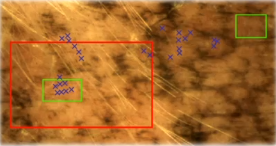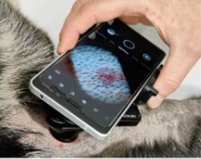Project title:
"Biophotonics in veterinary medicine - administration and first steps (GoBVM)."
Project contract number:
1.1.1.2/VIAA/3/19/455
Project partners:
Pet City, SIA (Dr. Alla Olivrī, vet)
Vets4science d.o.o (Dr. Aleksandar Plavšić, vet)
College of Veterinary Medicine, the Ohio State University (Prof. Laura Selmic, vet)
Project implementation deadline:
36 months (01.05.2020. – 30.04.2023.)
Total project funding:
133805,88 EUR (ERAF, 85%: 113734.99 EUR, state budget, 10%: 13380,58 EUR, private funding from UL, 5%: 6690,31 EUR)
Research manager:
Blaž Cugmas (Biophotonics laboratory)
About the project:
This postdoctoral project (GoBVM) aims to increase the use of biophotonics in veterinary medicine. An extensive literature review and an interdisciplinary panel of experts will identify key veterinary issues that could be addressed by biophotonics. Some of them will be considered during the proposed project using existing and self-developed biophotonics technologies (infrared thermometer, multichannel photoplethysmography (PPG), hyperspectral imaging, optical coherence tomography). First, we will reduce animal stress by measuring body temperature in dogs and cats. In addition, a complex PPG system will be used to monitor fully conscious (non-anesthetic) dogs and cattle (heart rate, changes in blood pressure and heat). Finally, the challenge for the project will be to develop advanced optical systems for invasive fine needle aspiration cytology (FNAC) for the detection of skin tumors in dogs and cats. GoBVM will expand the use of veterinary biophotonics, which can improve animal and human health.
Project results, etc. information on project implementation:
1. Prospective review document on biophotonics in veterinary medicine
We will conduct a literature search for research using biophotonics or biomedical optics in veterinary medicine using five databases: Web of Science (Thomson Reuters), Pubmed, Google Scholar, SPIE Digital Library, and OSA Publishing. The studies selected will have to clearly set out the objective of solving the veterinary problem. Therefore, if animals were used as models or if the purpose of the animals is not clear, the article will not be taken into account. The search strategy will be based on keywords such as: 'veterinary medicine', 'biophotonics', 'biomedical optics', 'pets', 'companions', 'diagnostics', etc. After reviewing and analyzing the selected studies, promising veterinary challenges (preventive, diagnostic, prognostic and therapeutic) will be sought, which could be addressed through biophotonics and biomedical optics.
Results:
- a review article (published in journals or conference proceedings with a citation index of at least 50 percent of the industry average citation index),
- participation, presentations, presentations by the invited person, and personal discussions at photonics and veterinary conferences,
- Scientists' Night presentation and article in a local newspaper.
2. Non-contact temperature measurements
We will develop a non-contact infrared thermometer using one of the medical IR sensors. The sensor will be housed in a compact housing. The measured data will be sent via Bluetooth to the mobile phone, which will allow the user to conveniently perform clinical measurements. The thermometer will be clinically tested on dogs and cats (Pet City SIA). During preliminary measurements, we will identify the most successful measurement sites on the body by comparing IR to rectal temperature. Thereafter, measurements will be performed only at selected body locations for a larger number of animals. In parallel, animal protection indicators will be developed to help us confirm our hypothesis that non-contact IR temperature measurements are more pleasant for an animal compared to the traditional rectal method.
Results:
- IRT device (new product and technology that can be commercialized),
- publication in a veterinary journal (published in journals or conference proceedings with a citation index of at least 50% of the industry average citation index),
- communication activities with animal owners.
3.PPG monitoring
We will modify an existing photoplethysmography (PPG) device operating in an Arduino environment. We will add additional pulse oximeter and ECG diodes to obtain additional PPG parameters such as pulse propagation time (PTT) and pulse arrival time. The new device will be validated for dogs (Vets4science). PPG and ECG data will be obtained from animals under general anesthesia (during surgery). The signal will be processed and compared with physiological parameters such as heart rate, respiration rate and blood pressure. In addition, the device will be tested to determine the heat of the cattle. In addition to obtaining a PPG signal (changes in vulvar blood volume), the presence and size of blood progesterone and corpus luteum will be measured.
Results:
- PPG device (new product and technology that can be commercialized),
- two conference publications,
- PPG data published in Zenoda.
4. Tumor biophotonics
We will select potential biophotonic methods to detect and differentiate skin and subcutaneous tumors in dogs and cats. The selection will be based on the knowledge gained during WP1 (Biophotonics Review). In addition to our (various spectral and fluorescence imaging methods) and partner devices (College of Veterinary Medicine, the Ohio State University), you can look for additional methods (eg photoacoustics). The selected methods will then be tested clinically. First, an animal (dog or cat) that has undergone elective tumor extraction will be subjected to general anesthesia and shaved hair in the tumor area. Optical measurements and FNAC (cytology, current clinical standard) will then be performed. Upon completion of the operation, the excised tumor will be sent for histopathological evaluation by a pathologist, which will be our gold standard. Optical measurements will be analyzed according to the technology (eg chromophore, vascular density calculations, etc.). Based on the gold standard, the sensitivity and specificity of each biophotonic technique and FNAC (ability to detect malignancies) will be calculated.
Results:
- an article in a reputable biophotonics journal (published in journals or conference proceedings with a citation index of at least 50 percent of the industry average citation index)

 CONFERENCE
CONFERENCE
